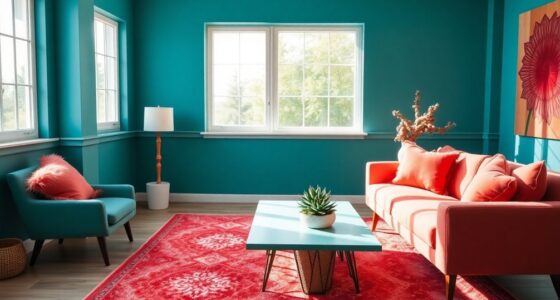To create a harmonious monochromatic room, start with a main color that sets the desired mood, then explore its various shades, tints, and tones to add depth and interest. Choose furniture in textures and finishes that complement your color palette and consider layered lighting to enhance subtle variations. Balance different tones with thoughtful furniture placement to achieve an elegant, unified space. Keep exploring the tips below to learn how to perfect your monochromatic design.
Key Takeaways
- Select a primary color and explore its shades, tints, and tones to add depth and interest.
- Use layered lighting to highlight subtle tone variations and create a warm or cool ambiance.
- Incorporate different textures and finishes within the same color family to enhance visual richness.
- Choose furniture that either seamlessly blends or contrasts through texture and form for visual balance.
- Balance tone variations with well-selected furniture to craft a harmonious and sophisticated space.

Designing a monochromatic room might seem challenging at first, but it’s actually a straightforward way to create a cohesive and stylish space. The key lies in selecting the right color palette and carefully considering your furniture selection. When you choose a single hue to base your room around, you’re laying the foundation for harmony through subtle tone variations. This approach makes it easier to achieve a balanced look because everything naturally complements each other, reducing the risk of clashing colors or visual chaos.
Start by picking your main color. Think about what mood you want to set—calm and soothing with soft blues, or warm and inviting with earthy browns. Once you’ve pinned down your primary hue, explore its different shades, tints, and tones. For example, if you opt for blue, incorporate navy, sky, and slate to add depth and interest without breaking the monochromatic theme. This variation in tone is what gives your space dimension and richness while maintaining unity. Your color palette acts as the backbone of the design, guiding all other choices to stay aligned with your overall vision.
Next, focus on your furniture selection. It’s important to choose pieces that either blend seamlessly with your color palette or stand out through texture and form. When you select furniture, consider the finish and material—matte, glossy, or textured surfaces can all influence how the color appears under different lighting. For example, a matte-finished, light gray sofa can soften the room, while a sleek, dark wood coffee table adds contrast and visual interest. Keep in mind that mixing different textures within the same color family can elevate the aesthetic without disrupting the monochromatic harmony. You might incorporate a plush velvet armchair in a deeper tone or a woven throw in a lighter shade to add tactile appeal.
Lighting plays a pivotal role in a monochromatic room, highlighting the various tones of your color palette and emphasizing your furniture choices. Use layered lighting—ambient, task, and accent—to bring out the subtle variations in your color scheme. Soft lighting can enhance the warmth of a beige palette, while cooler light can accentuate blues or grays. Additionally, understanding resources and tools available for interior design can help you visualize and implement your monochromatic theme more effectively.
In essence, creating a monochromatic room involves thoughtful selection of your color palette and furniture. When you balance tone variations with carefully chosen pieces, you craft a space that feels unified yet dynamic. The result is a room that exudes harmony, sophistication, and comfort—all achieved through the artful manipulation of color and furniture.
Frequently Asked Questions
How Can I Add Texture to a Monochromatic Room?
You can add texture to a monochromatic room by incorporating textured wall finishes like stucco or wood panels, which create visual interest. Layered textiles such as plush rugs, throw blankets, and cushions also bring depth and tactile variety. Mixing these elements helps break up uniform tones, making your space feel more inviting and dynamic without losing the monochromatic harmony. Keep it balanced to maintain a cohesive and sophisticated look.
What Lighting Enhances Monochromatic Color Schemes?
Imagine a cozy monochromatic living room. You enhance it by choosing layered lighting fixtures, like wall sconces and a table lamp, to add depth and warmth. Natural daylight also plays a vital role, highlighting subtle tone variations. Combining these lighting sources creates a dynamic, inviting atmosphere, emphasizing your monochromatic scheme’s richness. You’ll find that well-placed lighting fixtures and ample natural daylight transform the space beautifully, making it feel harmonious and lively.
Which Color Tones Work Best Together in Monochromatic Designs?
You should choose color tones within the same hue but vary their saturation and brightness for a cohesive look. Focus on a balanced color palette selection that includes light, mid, and dark shades to create subtle tone contrast. This approach adds depth and interest without disrupting harmony. Stick to a single color family, like blues or grays, and play with tone variations to achieve a sophisticated, monochromatic design.
How Do I Prevent a Monochromatic Room From Feeling Dull?
Did you know that 75% of people feel more relaxed in monochromatic spaces? To prevent dullness, use tone variation techniques like adding texture, incorporating different finishes, or layering shades for depth. Monochromatic color psychology shows that varying tones can evoke different emotions, keeping your room lively. By mixing light and dark shades strategically, you create visual interest and harmony, ensuring your space remains engaging without losing its cohesive feel.
Can Monochromatic Rooms Suit Small Spaces Effectively?
Yes, monochromatic rooms work well in small spaces. To make them feel inviting, focus on smart furniture placement that maximizes space and flow. Use decorative accents in slightly different tones or textures to add depth and interest without clutter. Keep the color palette cohesive and light to prevent the room from feeling cramped. This approach creates a harmonious, visually appealing environment that feels spacious and balanced.
Conclusion
By mastering tone variations, you can create a monochromatic room that feels both harmonious and inviting. Think of it like a symphony where each note complements the others, resulting in perfect balance. Don’t be afraid to experiment with different shades—your space will become a soothing retreat that reflects your style. When you play with tones like a painter blending colors, you craft a room that’s uniquely yours, as comforting as a familiar melody.









